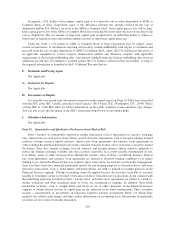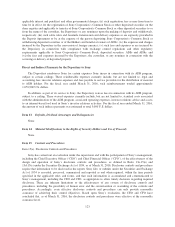Sony 2015 Annual Report Download - page 118
Download and view the complete annual report
Please find page 118 of the 2015 Sony annual report below. You can navigate through the pages in the report by either clicking on the pages listed below, or by using the keyword search tool below to find specific information within the annual report.The following is a summary of the principal Japanese tax consequences (limited to national taxes) to non-
residents of Japan or non-Japanese corporations without a permanent establishment in Japan (“non-resident
Holders”) who are holders of shares of Common Stock of Sony Corporation or of ADRs evidencing ADSs
representing shares of Common Stock of Sony Corporation. The information given below regarding Japanese
taxation is based on the tax laws and tax treaties in force and their interpretations by the Japanese tax authorities
as of June 17, 2016. Tax laws and tax treaties as well as their interpretations may change at any time, possibly
with retroactive effect. Sony Corporation will not update this summary for any changes in the tax laws or tax
treaties or their interpretation that occurs after such date.
Generally, non-resident Holders are subject to Japanese withholding tax on dividends paid by Japanese
corporations. Such taxes are withheld prior to payment of dividends as required by Japanese law. Stock splits are,
in general, not a taxable event.
In the absence of an applicable tax treaty, convention or agreement reducing the maximum rate of Japanese
withholding tax or allowing exemption from Japanese withholding tax, the rate of Japanese withholding tax
applicable to dividends paid by Japanese corporations to non-resident Holders is generally 20.42 percent,
provided, with respect to dividends paid on listed shares issued by a Japanese corporation (such as the shares of
Common Stock or ADSs of Sony Corporation) to non-resident Holders other than any individual shareholder
who holds 3 percent or more of the total shares issued by the relevant Japanese corporation, the aforementioned
20.42 percent withholding tax rate is reduced to 15.315 percent for dividends due and payable on or before
December 31, 2037. Due to the imposition of a special additional withholding tax (2.1 percent of the original
withholding tax amount) to secure funds for reconstruction from the Great East Japan Earthquake, the original
withholding tax rates of 15 percent and 20 percent as applicable, have been effectively increased to
15.315 percent and 20.42 percent, respectively, until December 31, 2037.
As of the date of this document, Japan has income tax treaties, conventions or agreements in force, whereby
the above-mentioned withholding tax rate is reduced, in most cases to 15 percent or 10 percent for portfolio
investors (15 percent under the income tax treaties with, among other countries, Belgium, Canada, Denmark,
Finland, Germany, Ireland, Italy, Luxembourg, New Zealand, Norway, Singapore and Spain, and 10 percent
under the income tax treaties with, among other countries, Australia, France, Hong Kong, the Netherlands,
Portugal, Sweden, Switzerland, the U.K. and the United States). Under the Treaty, the maximum rate of Japanese
withholding tax that may be imposed on dividends paid by a Japanese corporation to a U.S. holder that does not
own directly or indirectly at least 10 percent of the voting stock of the Japanese corporation is generally reduced
to 10 percent of the gross amount actually distributed, and dividends paid by a Japanese corporation to a
U.S. holder that is a pension fund are exempt from Japanese income taxation by way of withholding or otherwise
unless such dividends are derived from the carrying on of a business, directly or indirectly, by such pension fund.
If the maximum tax rate provided for in the income tax treaty applicable to dividends paid by Sony
Corporation to any particular non-resident Holder is lower than the withholding tax rate otherwise applicable
under Japanese tax law, or if any particular non-resident Holder is exempt from Japanese income tax with respect
to such dividends under the income tax treaty applicable to such particular non-resident Holder, such non-
resident Holder who is entitled to a reduced rate of or exemption from Japanese withholding tax on payment of
dividends on shares of Common Stock by Sony Corporation is, in principle, required to submit an Application
Form for Income Tax Convention Regarding Relief from Japanese Income Tax and Special Income Tax for
Reconstruction on Dividends (together with any other required forms and documents) in advance through the
withholding agent to the relevant tax authority before the payment of dividends. A standing proxy for non-
resident Holders of a Japanese corporation may provide this application service. In this regard, a certain
simplified special filing procedure is available for non-resident Holders to claim treaty benefits of exemption
from or reduction of Japanese withholding tax, by submitting a Special Application Form for Income Tax
Convention Regarding Relief from Japanese Tax and Special Income Tax for Reconstruction on Dividends of
Listed Stock (together with any other required forms and documents). With respect to ADSs, this reduced rate or
exemption is applicable if the depositary or its agent submits two Application Forms (one before payment of
dividends and the other within eight months after the record date concerning such payment of dividends). To
claim this reduced rate or exemption, a non-resident Holder of ADSs will be required to file a proof of taxpayer
118
























